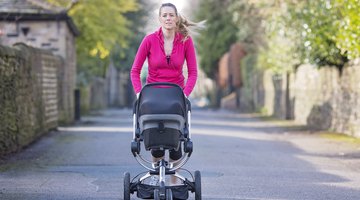Return to Fitness With These 10 Postpartum Exercises
Having a baby is a beautiful -- and life-altering -- event. In addition to the joy and excitement you'll feel at the birth of your new little one, pregnancy and giving birth to your baby will also transform your body both in ways you can see (hello, stretch marks) and can't see, as your muscles and joints have undergone tremendous stress over the past 10 months or so. But have no fear. With some patience and exercise, you can get back into shape. Just remember to be kind to yourself along the way. You didn't gain the weight overnight, so you're not going to lose it overnight, either.
0-3 Months: Easing Back Into Exercise
New moms who restart their exercise program after delivery can experience more rapid physical and emotional recovery, lower incidence of postpartum depression, better abdominal muscle tone and improved ability to lose both weight and fat gained during pregnancy, says Jennifer Tucker Johnson, founder of Fit for Expecting, a fitness and nutrition center for prenatal, expecting and postpartum women in Pasadena, CA. "Every woman is different, and there is no one-size-fits-all exercise program," she says. "Be sure to talk to your health-care provider before beginning an exercise program." Most will advise you to wait until you have your six-week postpartum doctor's appointment to make sure you're recovering well. Though if you exercised through your pregnancy, had a complication-free vaginal birth and are in generally good health, you can begin light exercise (like walking, modified calisthenics and stretching) a few days after giving birth. If you had a c-section or had to stop exercising before giving birth, wait to get the OK from your doctor.
Related: 12 Safe Exercises to Stay Fit During Pregnancy
1. Kegels and Belly Breathing

Postpartum Fitness: A Week-by-Week Plan to Feeling Like Yourself Again
Learn More
Your body, especially your abdominals and pelvic floor, go through a lot during pregnancy, labor and delivery. The days following childbirth are an important time to start the recovery process for your abs and pelvic floor. Perinatal exericse specialist Jennifer Tucker Johnson recommends Kegel exercises and diaphragmatic, or belly, breathing. "These safe exercises will start rebuilding the foundation that you need to later restart a regular exercise program," she says. And if you had an episiotomy or tearing during labor, Kegels bring more blood to the area and help you heal more quickly, says Jyothi Larson, yoga instructor and author of "Yoga Mom, Buddha Baby." HOW TO DO THEM: For Kegels, squeeze your pelvic floor muscles (the ones that stop the flow of urine) and hold for five to 10 seconds at a time. For diaphragmatic breathing, take a deep breath in, allowing your diaphragm (muscle right below your lungs) expand and contract as you breathe. Focus on your abdominal muscles as you breathe in and out, completely filling and emptying your lungs with each breath.
Related: 15 Exercises Every Woman Should Do to Improve Her Sex Life
2. Gentle Neck Rolls
Half and full neck rolls are an option even moms who've had cesarean sections can choose. It's a simple exercise that can help ease the pain of enlarged breasts, breast-feeding and carrying the baby. HOW TO DO THEM: Relax and drop your shoulders. Next, drop your head so your chin is pointed toward your collarbone. Now gently move your head from side to side for half circles, and then all the way around for full circles, while breathing deeply, says yoga instructor Jyothi Larson. Perform neck rolls while seated in a chair, sitting on the floor or standing with good posture.
Related: 9 Moves You Can Do Every Day for Better Joint Mobility
3. Walking and Pelvic Tilts

Best Exercises by Trimester
Learn More
Walking is an easy way to get back into exercise, and you can do it around the block with your baby, spouse or friends if weather permits. And pelvic tilts will help with your help mobility and flexibility, while strengthening the same muscles Kegels do. With either activity, pay attention to your pelvic floor muscles. If you have any urine leakage, your body is not ready, yoga instructor Jyothi Larson says. Keep the pelvic-floor test in mind any time you increase the intensity of an exercise. If you feel pain or notice an increase in bleeding, discontinue the exercise. HOW TO DO THEM: Lie on the floor, bending your knees, and plant your feet on the floor with your pelvis tilted upward. Place your hands on your hips and slowly tilt your pelvis back and forth. You can also perform this move while standing if you notice any back pain while doing it lying down.
Related: An Easy Exercise With 31 Proven Health and Fitness Benefits
3-6 Months: Progress Slowly But Surely
After three to four months have passed, your baby is older and your body may be starting to feel like your own again. This means you can safely and confidently do more exercises (doctor permitting, of course). The list includes light-impact exercise, water aerobics, walking and yoga. Just pace yourself. "It can be tempting to do too much too soon, since you're likely not pleased that you're carrying some extra weight and your mid-section is far from toned," yoga instructor Jyothi Larson says. "Listen to your body and know that it takes time, and with proper exercise and nutrition, your body will change."
Related: Best Exercises Post Baby
4. Bridge Pose
The bridge works your glutes, which helps alleviate stress on the lower back and stretches the front of the thighs, yoga instructor Jyothi Larson says. HOW TO DO IT: Lie on your back. Bend your knees and keep the soles of your feet on the floor. Bring your belly button back toward your spine, and then squeeze your buttocks and raise your hips off the floor. In addition to your buttocks, lift up and contract your pelvic floor muscles. Hold the pose for as long as it feels good (aim for 15 to 30 seconds).
Related: The Best Yoga Moves for Your Back
5. Knees-to-Chest Rock
Like the bridge pose, the knees-to-chest rock relieves tightness in the lower back while strengthening your abdominal muscles, yoga instructor Jyothi Larson says. HOW TO DO IT: Lie on your back with your legs and arms extended straight. Bring your knees to your chest and wrap your arms around your legs so you're rolled into a ball. Rock gently from side to side and then front to back for as long as it feels good.
Related: Sign Up to Receive the FREE LIVESTRONG.COM Weekly Newsletter!
6. Brisk Walking and Jogging
Brisk walking and jogging are helpful to add once your body has healed and your stamina has improved. In fact, there's a whole industry dedicated to running and jogging strollers, aimed to motivate moms to get out there and move with their babies along for the ride. It's a great way to spend time with your little one, exercise, and get some much needed fresh air and sunshine. Again, don't rush yourself; and if it hurts, stop.
Related: 12 Essential Tips for New Runners
6-12 Months: Build Back to Pre-Pregnancy Exercise
After six months to a year have passed, you and your baby should be in better shape. He or she is hopefully sleeping through the night more and starting to eat solid foods. And you? Well, you're eager to be back in fighting shape. The good news is that you can get there by adding some more intense moves, as long as you've been consistent with building up your fitness level to this point. If you haven't start with a good base and build your way back up to your pre-pregnancy workouts.
Related: Better Body After Baby? It’s Possible!
7. Plank Pose
The plank pose builds endurance in the core, including your abs and back and stabilizer muscles, yoga instructor Jyothi Larson says. HOW TO DO IT: Lie face down, resting on your forearms. Place your hands below your shoulders and slowly push off your knees and onto your toes like you're doing a push-up. Keep your back straight, tilt your pelvis and contract your stomach muscles to prevent your butt from sticking up in the air. Hold the pose for 10 to 30 seconds, or for as long as it feels comfortable, drop down, and then repeat.
Related: Moves for a Stronger Core and Better Posture
8. Lunges
Lunges strengthen the hamstrings, glutes and quadriceps. Lunges also improve your balance, yoga instructor Jyothi Larson says. HOW TO DO IT: Stand up straight. Step forward and bend your knees, lowering your body so both knees form a right angle and your back knee is almost touching the floor. Make sure your front knee doesn't go beyond your toes. Hold for a beat, step back to standing and repeat on the other leg.
Related: 22 New Lunges to Supercharge Leg Day
9. Squats
Squats can strengthen your abdominals, as well as your glutes, quadriceps and hamstrings. HOW TO DO IT: Stand with your feet shoulder-width apart. Place your hands on your hips or straight out in front of you and lower your body by bending your knees as if you're sitting back into a chair. Hold and repeat. Aim for five to 10 reps and build up from there.
Related: 12 Essential Squat Variations to Try
10. Bent-Over Rows
Row exercises strengthen the middle of your back and your arms, because you're pulling the weight toward your chest. It's a move that can be done using free weights -- no more than five to 10 pounds each -- or a machine at the gym, depending on your level of comfort. HOW TO DO THEM: Grab a dumbbell in one hand and brace your other hand and the knee on that side on a weight bench, letting the weight hang toward the ground at shoulder level. Using your shoulder and upper back muscles, pull the weight up toward your chest. Hold for a moment then lower the weight back down slowly and with control.
Related: Sign Up to Receive the FREE LIVESTRONG.COM Weekly Newsletter!
What Do YOU Think?
Have you recently given birth? Congrats on the new addition to your family! Were you active during your pregnancy? Are you anxious to get back into exercising? Which of these exercises will you start with? Which other ones are you going to add into your routine? Share your suggestions and stories in the comments section below so that other moms in the LIVESTRONG.COM community can benefit from your experiences.
Related: The Perfect Post-Pregnancy Workout to Get Back in Shape











